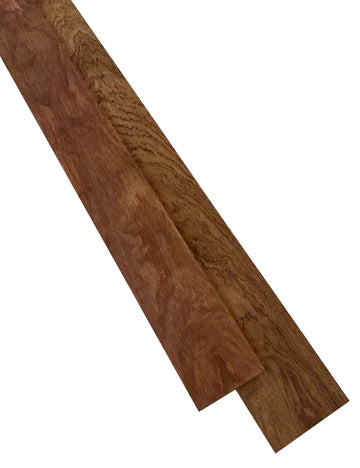Bubinga wood is a popular hardwood used for furniture and other wood products. It has a beautiful reddish-brown color and a tight grain, which makes it both strong and attractive. But what are the pros and cons of Bubinga wood? And where can you buy products made from Bubinga? Let us discuss it!
Where can we find Bubinga wood?
The Bubinga tree is native to Central and West Africa and can grow up to 130 feet tall.
How can we Identify the Bubinga tree?
- The wood from the Bubinga tree has a beautiful reddish-brown color that can range from light pink to deep red.
- Bubinga wood has a unique interlocking grain with a coarse texture, making it very strong and durable.
- Bubinga is reported to have an unpleasant scent once the Bubinga lumber continues to be wet, which disappears when the wood is dry.
Workability of Bubinga wood
- Although Bubinga wood differs from species to species, Some of the Bubinga wood contains little amount of silica, which prematurely dulls cutting tools and machines.
- And also the Bubinga pieces with patterned or interlocked grain cause tear-out.
What is Bubinga wood used for?
- Bubinga wood is also known for its strength and resistance to wear, decay, and shock. With a tight grain pattern and good working properties, Bubinga makes an excellent choice for many woodworking projects.
- In furniture making, Bubinga is highly sought after because of its beauty and durability.

- Bubinga wood is commonly used in cabinets and other high-end furniture pieces, both as accent wood and as the main material.
- Bubinga tree is usually used in veneer, inlays, fine pieces of furniture, cabinetry, turnings, and different specialty things.
- Natural edge slabs from the Bubinga wood are also used in table tops and Specialized projects.
- The Timber of Bubinga is also used by Artists and in modern arts, for inlays and the manufacture of high-end furniture.
- The natural luster of Bubinga wood offers decorative elements on smaller pieces like jewelry boxes or ornamental carvings.

- In instrument making, Bubinga wood has become popular for guitars, drums, and other stringed instruments due to its tight grain structure that creates superior tonal resonance when it’s worked with precision tools.

- Bubinga’s strength and hardness during turnings such as pool cues and knife handles are pretty impressive.
Take a look at Bubinga Turning Blanks
The Pros and Cons of Bubinga wood
The pros of Bubinga wood include its beauty, strength, durability, and resistance to wear. It is often used in furniture making due to its attractive appearance and long-lasting quality.
The cons of Bubinga wood include its cost, as it is often more expensive than other hardwoods. It can also be challenging to work with due to its density and toughness, although this makes it ideal for certain labor-intensive projects. Additionally, Bubinga's natural oils may cause staining if left untreated.
If you are looking for products made from Bubinga wood,
You are in the right place, Just click this to view the tremendous Bubinga wood products collection
Take the time to learn more about its pros and cons, so you can find the perfect piece of furniture or other product for your home or business! Thanks for reading, and
Check out Exotic Wood Zone for all of your hardwood needs!





